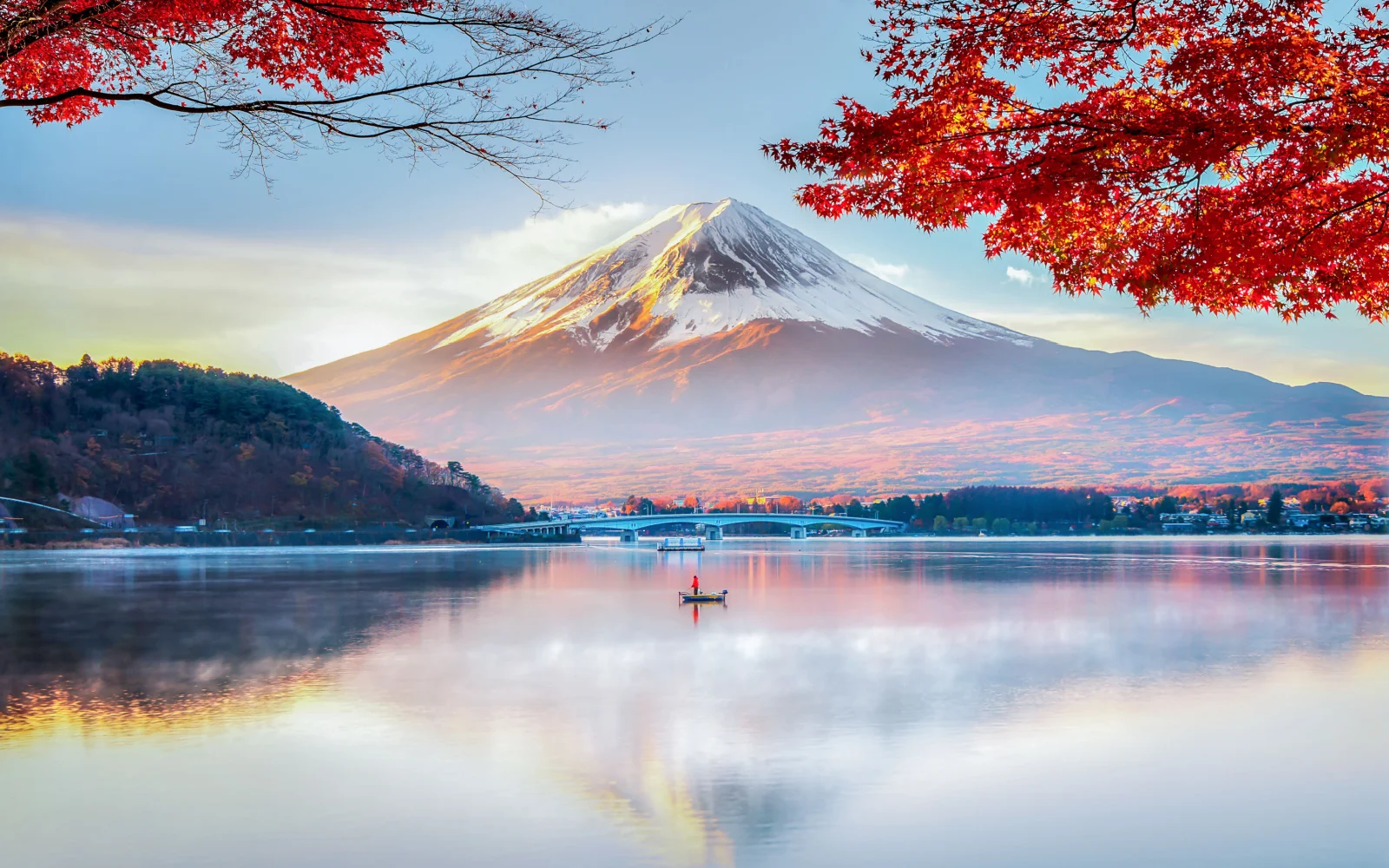The average cost of a trip to Japan in 2025
A seven-day trip to Japan for two people in 2025 costs around $6,100, covering accommodation, flights, food, activities, and transportation. The average daily accommodation cost is $150, with flights averaging $1,800 per ticket. On average, expect to spend about $150 per person per day on food, drinks, and activities, with transportation costs totaling approximately $60 per day for two people.
Japan offers a unique glimpse into a world where ancient traditions and modern innovations intertwine in perfect harmony. Every region has its own distinct charm and character, too, allowing you to easily plan your perfect adventure.
The sky is the limit to how you spend your time. Immerse yourself in Tokyo’s vibrant city life. Soak in the historical charm of Kyoto.
Or gaze in awe at the natural landscapes across the Kawaguchiko, Hakone and Hokkaido areas. It’s up to you. Ready to start planning your perfect trip? It all starts with a look at what it might cost.
Although trips to Japan have a reputation for being too expensive, we’re here to help you effectively budget your travels and see where to save money. Let us be your guide in figuring out where to stay, what to do and more while staying well within budget!
Average Trip to Japan Cost in 2025
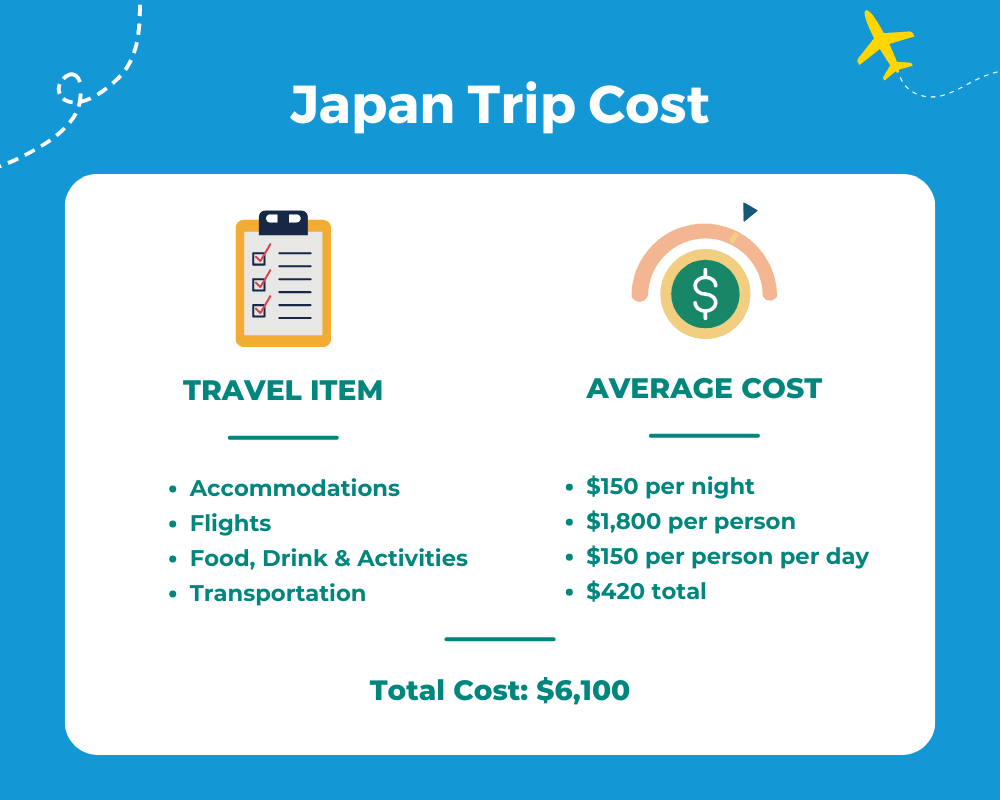
A seven-day trip to Japan for two people in 2025 will cost about $6,100.
- Average Accommodation Cost: $150 per night
- Average Flight Cost: $1,800 per ticket
- Food, Drink, & Activities: $150 per person, per day
- Transportation: $420
- Total Cost: $6,100
The average cost of a trip to Japan can vary significantly depending on your plans. Plane tickets are the biggest expense, although the price varies based on your travel date and departure location.
Besides the cost of tickets, where you stay and what you’ll eat may impact your budget the most.
If you stay at high-end luxury hotels, like the Ritz-Carlton Tokyo, a single night in the best room could cost up to $18,000. For a more budget-friendly trip, $25-a-night capsule hotels might fit the bill.
The same goes for where you’ll eat. Prices at iconic Michelin-star restaurants like Kyoto Kitcho Arashiyama go up to $900 per person. But there’s no reason you cannot spend your trip eating rich, flavorful ramen and street food like takoyaki for around $10 a meal.
You can make your trip as extravagant or cost-effective as you wish by reflecting on what matters most. Then, use this guide to zero in on all the best ways to cut costs on your travels to Japan.
Ready to Book?
Unlock Exclusive Discounts on Expedia.com!
Got Travel Insurance?
Protect yourself for unexpected interruptions.
Compare Plans We may be compensated when you book after clicking on one of our links.Japan Trip Cost: Average by Item
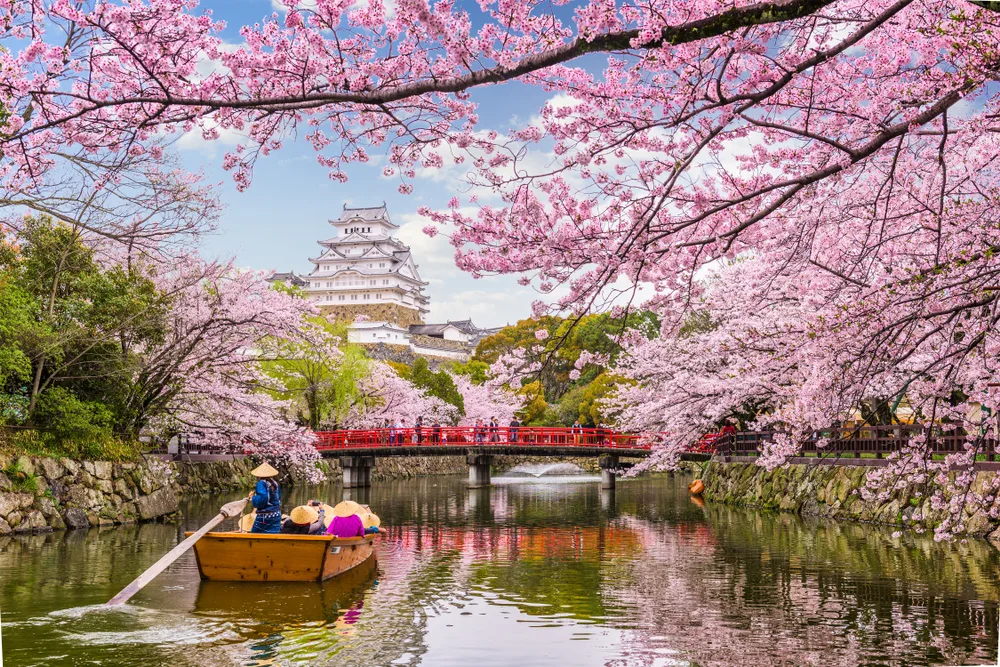
Sean Pavone/Shutterstock
The average costs for each travel budget item guide you on what to expect during your trip. Your actual costs will greatly depend on your personal selections as you enjoy all the country offers. Let’s take a look.
Accommodation Costs
On average, travelers to Japan spend about $150 per night for their accommodations. Costs vary wildly across the many different places to stay, however.
Five-star luxury hotels, including Aman Tokyo and Hyatt Regency Kyoto, are at the upper end of the price range. High-end rooms start at $500 a night but can total into the thousands depending on the selected hotel and suite.
Standard hotels are much more budget-friendly at $250 per night on average. Business hotels have fewer amenities, but they’ll do in a pinch and only cost around $50 a night.
Other super low-cost options include boutique hostels and capsule hotels for $25 and $45 a night per person, respectively. If you’d like to immerse yourself in Japanese culture, traditional ryokans are a must at least once.
For around $150 a night, Hotel Musashiya and other Japanese inns treat you to kaiseki meals, onsen soaks and cozy futon beds in rooms lined with tatami mats.
Similarly, there are temple lodgings with traditional furniture and décor, an open invitation to participate in meditation and morning prayers and simple yet decadent meals. Prices vary, but you can usually get a room for $75 a night per person.
Another popular option is minshuku, or Japanese-style bed and breakfasts, run by local families. For $75 a night per person, you get comfortable guesthouse lodgings, homecooked meals for breakfast and dinner and endless hospitality.
Flight Costs
Plane tickets are easily the biggest expense when traveling to Japan. Expect to pay $1,800 per ticket on average, although it could be more during peak travel times in the spring and fall.
For the biggest savings, plan your trip for the off-season instead. Ticket prices fall from October through February when temperatures drop to below freezing. During that time, it’s possible to find tickets as low as $585 each, depending on where you’re traveling from and your target destination.
Traveling from the East Coast of the US may add up to $1,000 to your ticket price compared to if you were departing from the West Coast.
As for destinations, the cheapest tickets go to Tokyo and have at least one stop in between. If you’d like to land in Misawa, Komatsu or Hiroshima, your tickets may cost at least $500 more. Direct flights are also more expensive.
The best way to keep your trip to Japan within your budget is by getting the best possible ticket deals. So, plan to travel when you find the lowest ticket prices. Rest assured that there’s almost no bad time to visit.
A visit in the fall lets you see the leaves change colors and brighten up the landscape. In the winter, cold temperatures make soaking in the picturesque views a welcome treat.
Visits during the spring allow you to dance in the billowing cherry blossoms. And in the summer, it’s festival time and the only season where you can climb Mt. Fuji.
Whatever you do, try to avoid visiting during the New Year’s holiday and Golden Week in May, when hotels and transit lines get overbooked.
Food, Drink, & Activity Costs
When it comes to food, drinks and activities, you have the freedom to either go all out or keep things modest. On average, most travelers spend about $150 total each day. Almost half of that goes to food and drinks, while the rest pays for activities.
If you’d only like to indulge in the finest creations at exclusive sushi-ya restaurants, your food and drink costs may far exceed the average. But you don’t have to go that route to delight your tastebuds at every meal.
Japan has nearly 1.5 million restaurants, with over 130,000 in Tokyo alone. So, you’re never far from truly delectable meals and the drinks to match.
To stay within budget, you could start your day with a $10 breakfast from a family restaurant like Coco’s or Joyfull. Or join the locals in stopping in at a nearby conbini, or convenience store, for rice balls, miso soup and other brekkie favorites.
Lunchtime specials are common, so it’s easy to save money there. Even ramen with all the fixings, including chashu, egg and green onions, costs less than $15 a bowl.
Want gyoza on the side? That’ll only cost $5 more. Japanese street food like takoyaki, candied fruit and senbei rice crackers also make for a tasty lunch.
If you’d like to splurge on dinner, Tendan Akasaka and other yakiniku eateries let you dine on wagyu beef and other fine meats for $50 per person on average. Izakaya-style dining is more affordable and just as good.
At these Japanese pubs, you’re welcome to order drinks and small bite plates to sample all the best dishes in one spot. As far as activities go, most places have low admission costs, making it easy to work with a $75-per-day budget.
For about $10, you could go to a karaoke parlor, visit the Snow Monkey Park, enjoy the view from the Tokyo Tower observatories, soak in an onsen or explore historical sites like Osaka Castle.
Unless you want to do a lot of window shopping, visiting all the shops in the Akihabara Electric Town district, Harajuku fashion district and other popular shopping areas in Tokyo might break the bank. Free activities like sightseeing at parks and beaches could offset your spending spree, though.
Don’t miss the chance to visit at least a few temples and shrines as well. They’re free to explore, but you’ll want to buy a goshuincho and pay for the stamps at each one for a beautiful memento of your travels.
Transportation Costs
While visiting Japan, transportation costs for two may work out to about $60 a day. Thanks to the efficient public transportation network, you don’t have to rent a car to get around.
Instead, you’ll either need to get a JR or regional rail pass before arriving or load up a Suica card. JR passes are $210 a week, allowing you to visit multiple regions at one low price. If you’re only staying in one region, you could get the regional rail pass for much less.
Most travelers can get by with a Suica, Pasmo or ICOCA card instead. With a quick tap, these reloadable cards let you pay for transit and buy items at vending machines and shops.
You can either get a physical card or add the card to your Apple Wallet. When you sign up, you’ll make a deposit of about $5 and then load it up with up to $145 each time. You may use the cards all over the country for $2 per trip and up.
Remember that you can only get your deposit back if you ask for a refund of your unspent balance in the area where you bought the card. Overnight buses are another popular way to travel between regions.
These buses allow you to get a little shuteye while traveling across the country for about $50 on average. Fares vary depending on how luxurious the bus is and how far you travel.
Things to Consider
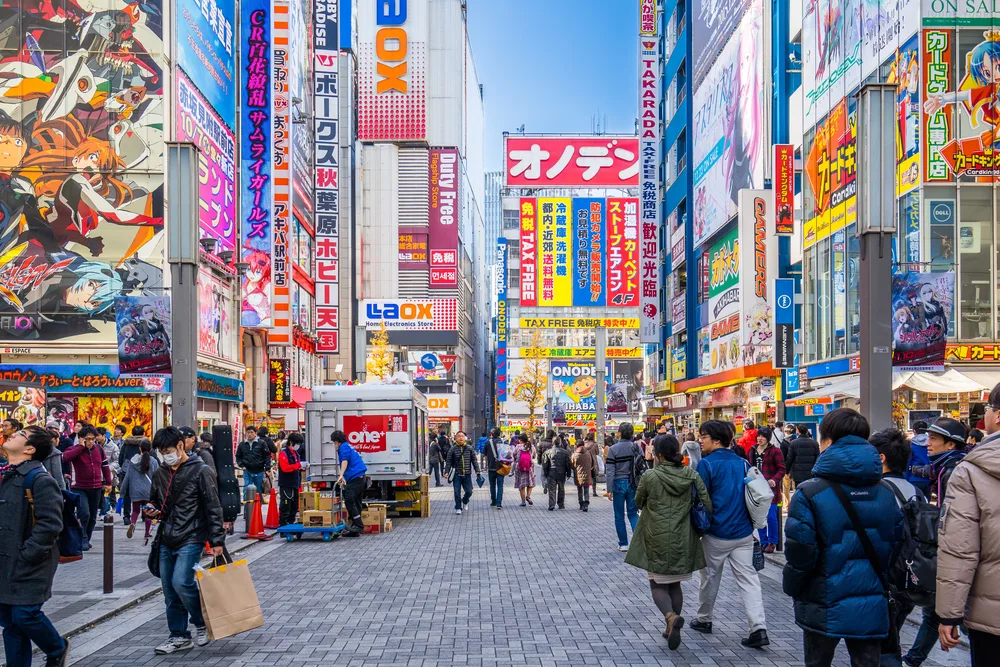
TOKYO, JAPAN – CIRCA JANUARY, 2016: Crowds pass below colorful signs in Akihabara. The electronic district has evolved into a shopping area for video games, anime, manga, computer/Easy Camera/Shutterstock
Here are some other things to consider when planning your vacation to Japan in 2025:
- Call the Japan Visitor Hotline if you need any help or information during your travels. It’s open 24 hours a day, 365 days a year, offering English, Chinese and Korean support.
- Do not hand your money directly to cashiers when making purchases. Put your cash or card on the tray instead. The cashier will also return any change owed to you using the tray.
- Use Google Lens to translate menus and road signs if there’s no English option available. Better yet, learn katakana and hiragana to read everything yourself.
- Buy handkerchief-sized towels at the conbini for drying your hands. Most public restrooms do not have paper towels or air dryers available.
- Get the Tokyo Museum Grutto Pass for discounts on admission to over 101 museums, zoos, aquariums, botanical gardens and other attractions.
- Pack comfortable slip-on shoes that you’ve already lightly broken in. You’ll be walking for miles each day and taking your shoes off repeatedly to enter many locations, including before going into dressing rooms to try on clothes.
Frequently Asked Questions
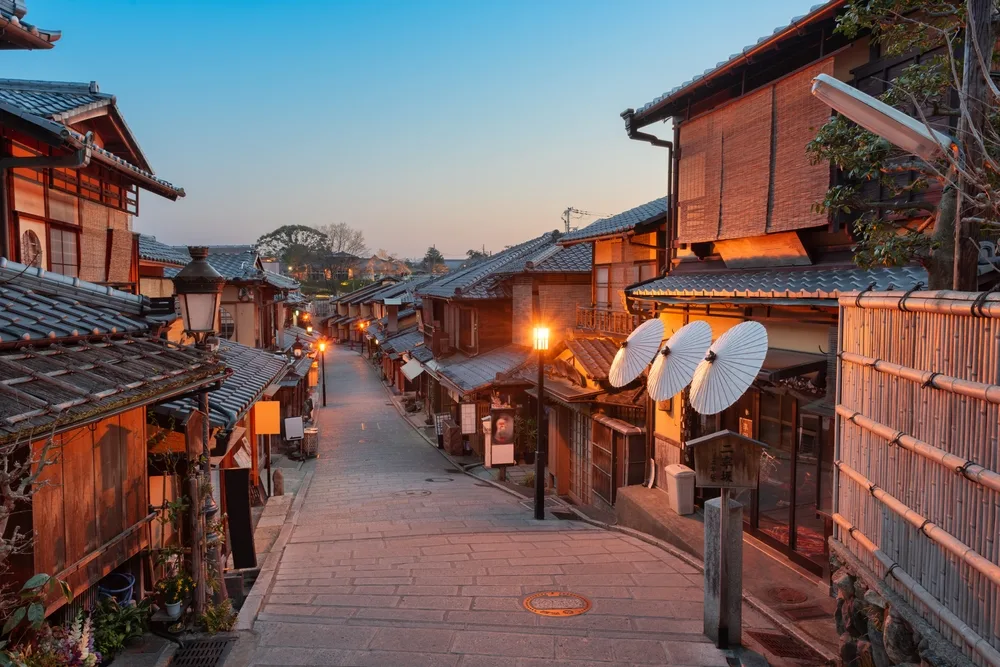
Kyoto, Japan old town streets at twilight in Highashiyama district
Are trips to Japan expensive?
The cost of a trip to Japan is far more reasonable than most people believe. It costs $6,100 on average for two people to spend a week in Japan. The most expensive part of the trip is the plane tickets, which cost anywhere from $585 to well over $2,500 each.
How much budget do I need to travel to Japan?
You might be able to get by on less than $100 a day if you choose low-cost food, drinks and activities while visiting Japan. Most people spend $150 per day on average, though. Plan on what types of places to dine at and which activities to choose if you’re working with a limited budget.
How long should I stay in Japan?
You’ll need at least a week to truly experience the magic of Japan. Two weeks is much better, especially if you want to travel to multiple regions during your visit. If you’re only going for three to five days, choosing one city to explore is best.
Which is the best time to visit Japan?
The gorgeous spring and fall months are the most popular times for Japan vacations. But there’s no bad time to visit. Cold winter weather makes onsen soaks a true delight. And the summer offers ample opportunities to enjoy festivals and other events.
Is Japan cash friendly?
Japan is cash friendly. But, the pandemic caused many businesses to accept cashless payment methods like credit cards and Apple Pay. The exceptions are ryokans, temples and small locally-owned eateries. It’s a good idea to carry cash with you in case your card’s not accepted or doesn’t work at certain places.
Don't waste your hard-earned money. Get the best deal on your trip by finding flight and hotel deals on Expedia.com!
- Options for all travel styles & budgets
- Hotel price match guarantees
- Exclusive last-minute deals
So, What’s a Trip to Japan Cost?
The trip of a lifetime to Japan awaits, and it’ll only cost you $6,100 on average. For that price, you’ll get plane tickets, accommodations, food and drinks, tons of daily activities and transportation for you and a friend.
| 🛎️ Average Accommodation Cost | $150 per night |
| ✈️ Average Flight Cost | $1,800 per person |
| 🍽️ Food, Drink & Activities | $150 per person per day |
| 🚕 Transportation | $420 total |
| 💲 Total Cost | $6,100 |
If that price seems too steep, there are ways to make your trip more affordable. Stay in modest business hotels, eat at ramen houses and enjoy free activities like visiting temples and parks.
However, if your budget allows, you can always go all out with luxury hotel stays and meals at Michelin-star restaurants.
Either way, you will embark on an unforgettable journey through Japan’s breathtaking cities and landscapes, creating memories to cherish forevermore. So, don’t wait another moment to work out your budget and book your trip today!



